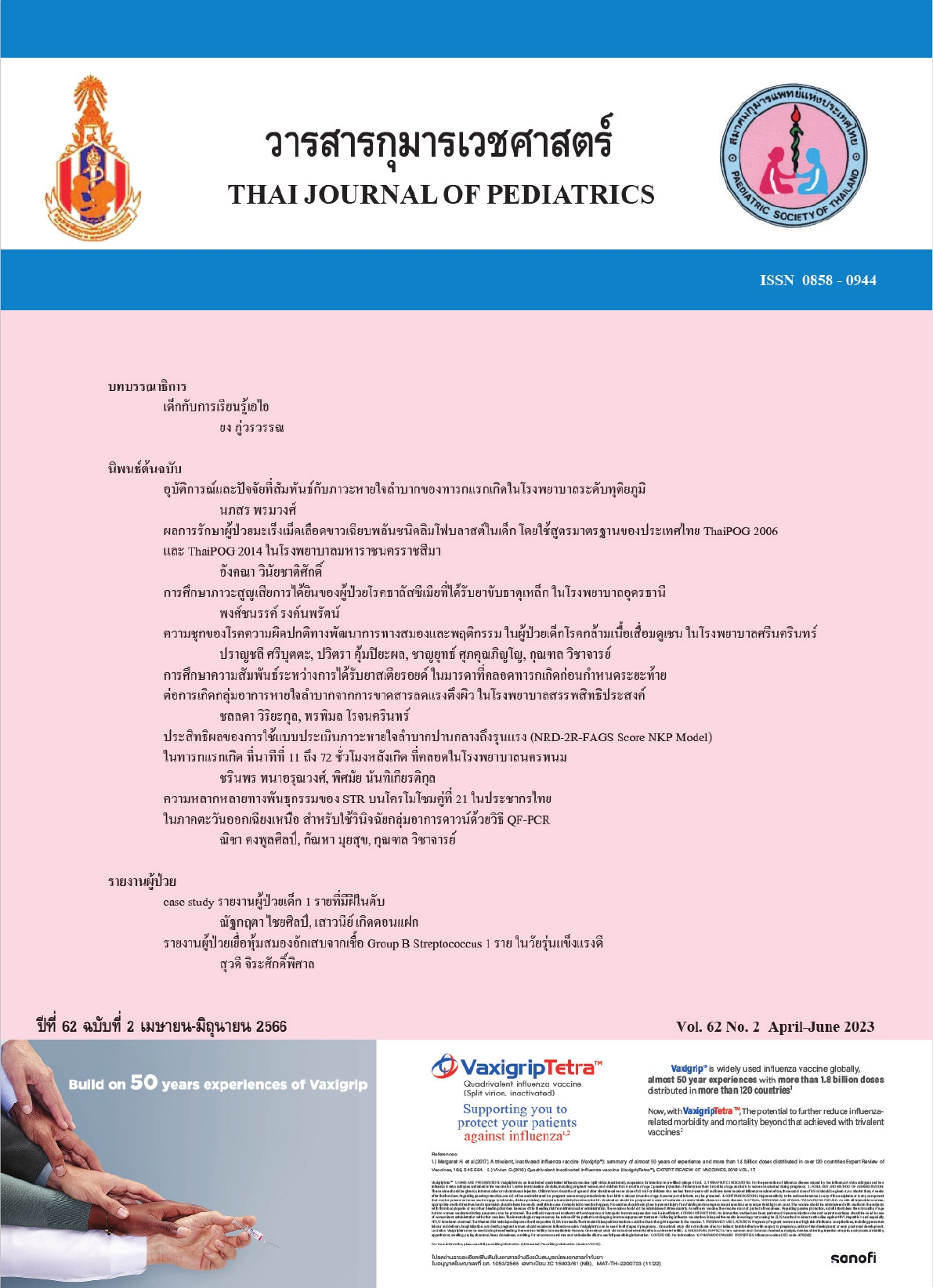Genetic polymorphism of STR loci on chromosome 21 in Northeastern Thai people for diagnosis of Down syndrome by QF-PCR
Keywords:
Short tandem repeats (STR), QF-PCR (Quantitative fluorescent PCR), Down syndromeAbstract
Background: Short tandem repeats (STR) are highly polymorphic microsatellites markers and widely used for making a diagnosis of Down syndrome (DS) by Quantitative fluorescent PCR (QF-PCR).
Objective: to determine the most appropriate STR markers for making a diagnosis of DS with QF-PCR in northeastern Thai people.
Material and method: The authors analyzed 26 blood samples of DS patients by QF-PCR and determined the most informative results. Blood samples from 191 normal northeastern Thai people were also analyzed to document the highest polymorphism.
Result and discussion: Among 6 STR loci, the top 3 informative STR loci were D21S11 (92.3%), D21S1411 (84.6%), and D21S1442(84.6%), respectively. The STR loci with highest coefficient of variation (CV) were D21S1444, D21S1437, and D21S1411, respectively. The top 3 informative STR loci can make a diagnosis of DS with a sensitivity of 96.1% that equal to the top 3 STR loci with highest CV. But D21S1437 and D21S1444 loci had allele with highest frequency 33.3 and 28.3%, respectively. So, the most appropriate STR loci are D21S11, D21S1411, and D21S1442.
Conclusion: The D21S11, D21S1411, and D21S1442 are the most appropriate STR loci for making a diagnosis of DS in Northeastern Thai people.
Downloads
References
Toth G, Gaspari Z, Jurka J. Microsatellites in different eukaryotic genomes: survey and analysis. Genome Res. 2000,10:967-81.
Fan H, Chu JY. A brief review of short tandem repeat mutation. Genomics Proteomics Bioinformatics. 2007;5:7-14.
Ellegren H. Heterogeneous mutation processes in human microsatellite DNA sequences. Nat. Genet. 2000;24:400–2.
Lander ES, Linton LM, Birren B, et al. Initial sequencing and analysis of the human genome. Nature. 2001;409(6822):860-921.
Huang Q.Y. Mutation patterns at dinucleotide microsatellite loci in humans. Am J Hum Genet. 2002;70:625-34.
Kayser M. Characteristics and frequency of germline mutations at microsatellite loci from the human Y chromosome, as revealed
by direct observation in father/son pairs. Am J Hum Genet. 2000;66(5):1580-8.
Chakraborty R, Kimmel M, Stivers DN, Davison LJ, Deka R. Relative mutation rates at di-, tri-, and tetranucleotide microsatellite loci.
Proc Natl Acad Sci USA. 1997;94(3):1041-6.
Bowcock AM, Ruiz-Linares A, Tomfohrde J, Minch E, Kidd JR, Cavalli-Sforza LL. High resolution of human evolutionary trees with polymorphic microsatellites. Nature. 1994;368(6470):455-7.
Hammond HA, Jin L, Zhong Y, Caskey CT, Chakraborty R. Evaluation of 13 short tandem repeat loci for use in personal identification applications. Am J Hum Genet. 1994;55:175-89.
Dib C, Faure S, Fizames C, et al. A comprehensive genetic map of the human genome based on 5,264 microsatellites. Nature. 1996;380:152-4.
Muthuswamy S, Agarwal S. Segmental Duplication QF-PCR: A Simple and Alternative Method of Rapid Aneuploidy Testing for Developing Country Like India. J Clin Lab Anal. 2017;31:e22038.
Lee MH, Ryu HM, Kim DJ, et al. Rapid prenatal diagnosis of Down Syndrome using quantitative fluorescent PCR in uncultured
amniocytes. J Korean Med Sci. 2004;19:341-4.
Mackic-Durovic M, Projic P, Ibrulj S, Cakar J, Marjanovic D. A comparative analysis of the effectiveness of cytogenetic and
molecular genetic methods in the detection of Down syndrome. Bosn J Basic Med Sci. 2014;14:94-8.
Svecova I, BurjanivovA T, Krsiakova J, et al. Rapid detection of the most common chromosomal aneuploidies in the secondtrimester
amniotic fluid using QF-PCR. Ceska Gynekol. 2013;78:373-8.
Guan L, Ren C, Li H, Gao L, Jia N, Guan H. Practicality of rapid prenatal screening for Down syndrome with PCR-short tandem
repeat method. Zhonghua Yi Xue Yi Chuan Xue Za Zhi. 2013;30:277-82.
Shi YF, Li XZ, Li Y, Zhang XL, Zhang Y, Yue TF. Diagnosis of Down’s syndrome using short tandem repeat loci D21S11, D21S1440
and Penta D. Zhonghua Yi Xue Yi Chuan Xue Za Zhi. 2012;29:443-6.
Kriventsova NV, Shokarev RA, Avrutskaia VV, et al. Use of quantitative fluorescence polymerase chain reaction in the invasive
prenatal diagnosis of Down’s syndrome. Klin Lab Diagn. 2010;:27-30.
Jain S, Agarwal S, Panigrahi I, Tamhankar P, Phadke S. Diagnosis of Down syndrome and detection of origin of nondisjunction by
short tandem repeat analysis. Genet Test Mol Biomarkers. 2010;14:489-91.
Liou JD, Chu DC, Cheng PJ, et al. Human chromosome 21-specific DNA markers are useful in prenatal detection of Down syndrome. Ann Clin Lab Sci. 2004;34:319-23.
Yang LL, Ou YH, Xu XM. Rapid molecular diagnosis of trisomy 21 using the PCR-STRSSCP technique. Zhonghua Yi Xue Yi Chuan
Xue Za Zhi. 2004;21:466-9.
Tóth T, Findlay I, Papp C, et al. Pre-natal detection of trisomy 21 and 18 from amniotic fluid by quantitative fluorescent polymerase
chain reaction. J Med Genet. 1998;35:126-9.
Zhu YN, Lu SM, Wang M, Shen FX, Chen Y, Hu JJ. Genetic analysis of STR markers on chromosome 21 in a Han population from southeast China. Genet Mol Res. 2015;14:1718-25.
Mann K, Fox SP, Abbs SJ, et al. Development and implementation of a new rapid aneuploidy diagnostic service within the
UK National Health Service and implications for the future of prenatal diagnosis. Lancet. 2001;358(9287):1057-61.
Wongkularb A, Rerkamnuaychoke B, Weerakiet S, Navephap S, Campiranon A. Genetic Diagnosis of Sex and Trisomies 13, 18, 21 in Human Single Cell Embryo by Multiplex Fluorescent Polymerase Chain Reaction. Kasetsart J. (Nat. Sci.). 2005;39:440-5.
Khorchai A, Rerkamnuaychoke B, Sangkitporn S, et al. Detection of Down Syndrome by Multiplex Fluorescent Polymerase Chain Reaction. Journal of Health Science. 2014;23(5),943-53.
Downloads
Published
How to Cite
Issue
Section
License

This work is licensed under a Creative Commons Attribution-NonCommercial-NoDerivatives 4.0 International License.



